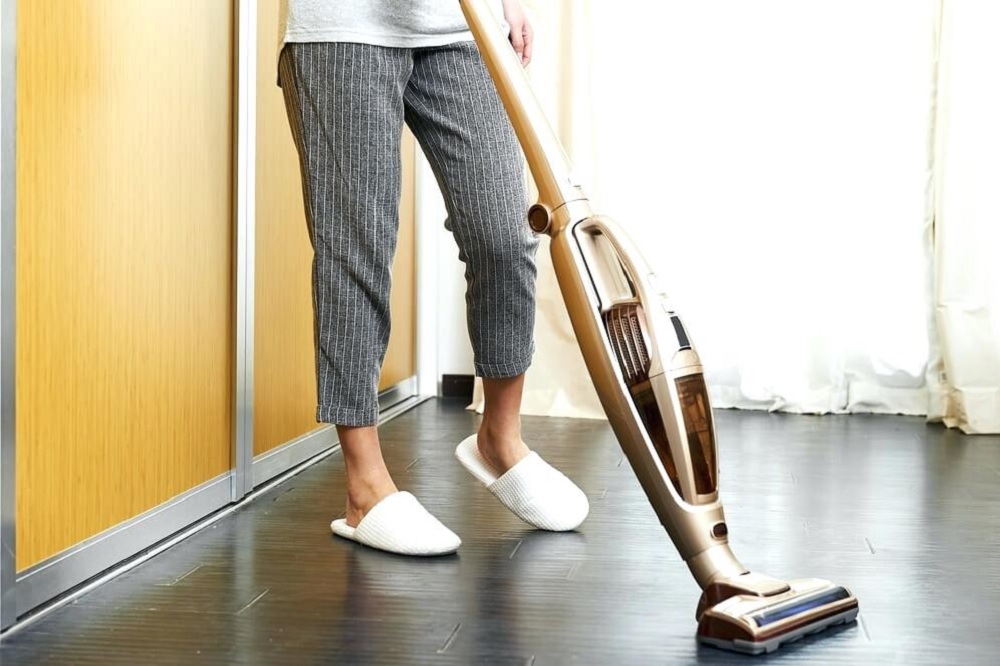We want you to save time and effort when you clean.
That’s why we’re going to show you how to dust almost everything with a vacuum cleaner.
Before we begin, here are the things you should never vacuum.
First, unless you have a shop vac, don’t suck up fine dust, fireplace ashes, or debris from construction.
This includes flour, baking soda, and even makeup.
If you try it, you’ll find that this kind of dust will clog your filter and possibly ruin your machine.
Also, avoid vacuuming wet or damp spills and glass.
Finally, please keep vacuum cleaners away from your electronics. Vacuums generate static electricity that could destroy your television, monitor, PC, and so forth.
Okay, now that we’ve covered the “don’ts,” let’s go over what you can clean with a vacuum.

Start at the Top and Work Your Way Outward
Go stand in the middle of the room you want to clean. Look up at the ceiling.
Are there cobwebs? Is there a ceiling fan? What about curtains?
Grab your trusty vacuum and pop on the extension wand.
Now it’s time to choose the proper attachment.
Fortunately, most of the best vacuums for carpets come with a generous assortment of options.
If you have a dusting brush, start with that.
The bristles are soft to not damage delicate surfaces or paint. It’s perfect for ceiling fans, high shelves, the tops of curtain rods, and air vents near the ceiling.
In fact, even if you don’t have a dusting brush, mount the attachment with the softest bristles.
Now it’s time to get to work. Start in the center of the room and move toward the edges as you vacuum all the high surfaces.
At the Perimeter of the Room, Work Your Way Downward
Once you finish the last corner, it’s time to move downward.
Keep the dusting brush mounted as you clean lamp shades, shelves, window ledges, the headboard of the bed, and the front and back sides of the doors.
Then switch to an upholstery attachment to dust furniture like the sofa. Be sure to lift up cushions.
Select the Right Setting for Your Floor
Have you moved toys and clutter off the floor? Then shift the chairs and tables, too. You want to be able to reach baseboards.
Hit those nooks and crannies and baseboards with the dusting brush or nozzle attachment before you put the wand away.
Next, it’s time to finish by cleaning the bottom of the room.
If you have laminate or hardwood, you can protect the surface by using a vacuum cleaner with a setting for bare floors.
Otherwise, remember to turn off the roller bar on your upright that you needed on the carpet.
Of course, you’ll need to change the attachment if you have a canister vacuum.
Now you’re ready to make slow, overlapping passes around the room. Trust us, it’s worth it to concentrate on this part so that you don’t have dust bunnies paying you a surprise visit later.
Happily, the best vacuums for tile floors have intense suction to pick up fine particles, which cuts down on how often you need to mop.
Wrap up by Taking Care of Your Tools
You may think that your job is done once you’ve finished vacuuming.
But it’s not.
Take a couple of extra minutes to do three things, and you’ll thank yourself later.
First, empty the dust bin even if it’s not full. If you have a bagged system, check it to see if the bag needs to be replaced.
Second, rinse air filters if possible and put them out to dry.
And third, clean beater bars and attachments to get rid of hair and fuzz.
If you want to go the extra mile, use a damp cloth to wipe down the extension wand, attachments, and outside of the vacuum.
Now it’s time to take a break.
Go admire your hard work. Isn’t it beautiful?